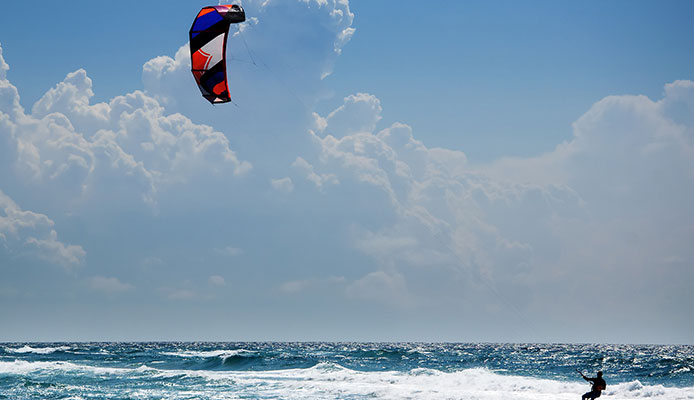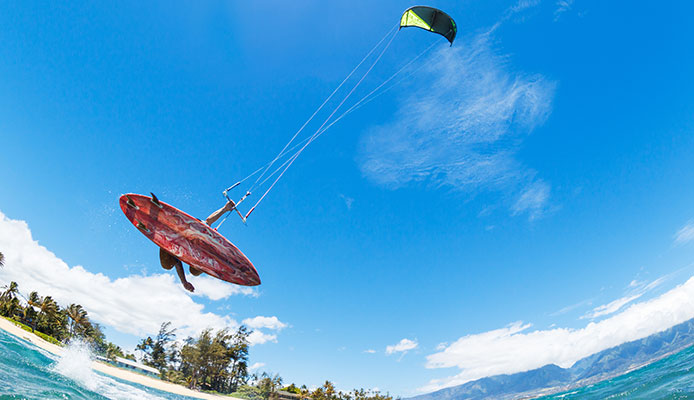
Though surfing and kitesurfing have a lot in common when it comes to riding waves, the 2 board sports also have some very distinct differences. One of the biggest dissimilarities is in the ideal wind speed.
For surfing, the best days are those that do not have any wind – or those with a light offshore wind which can make the waves “peel” and hold up for an extended period. For kitesurfing, you will need a lot of wind.
Putting a focus on how kitesurfing vs surfing compare and contrast, this guide will outline the major differences and similarities. If you are trying to decide which board sport suits you, making a decision will be much easier with our surfing vs kitesurfing guide.
A Guide to the Kitesurfing vs Surfing Similarities and Differences
1. Surfing vs Kitesurfing Learning Curve
While both kitesurfing and surfing have a steep learning curve, learning to kitesurf is usually faster compared to learning how to surf. Given the right gear and conditions, you can go from a newbie to kitesurfing waves in just a couple of weeks. On the other hand, surfing real waves typically needs a longer commitment.
Most surfing learners have to practice and get washed out in waves for dozens of hours before everything clicks and they start riding down waves. They need to invest time in learning how to catch more waves. Surfers have to know how to duck dive and paddle. While learning to surf can be fun, it can be a long, tedious process.
While kitesurfing can be hard in the beginning, most learners crunch through the learning curve fast with some initial lessons. Typically, beginners can get up and ride on twin-tip kiteboards after only 10 to 12 hours of guided instruction.
2. Kitesurfing vs Surfing Conditions
For both sports, you will need high-period swells featuring optimal orientation. The biggest distinction in the best conditions, however, is wind speed.
You will have maximum fun on your surfboard on days with no wind or those with a light offshore wind that makes the waves hold up longer. To enjoy kitesurfing, you will need a lot of wind, at the very least 12 knots and ideally, 15 to 25 knots. For kitesurfing, the wind direction should be either side-shore (parallel to your favorite beach) or side-onshore (coming from the sea at an angle).
Whether you have more kitesurfing or surfing days will depend on where your favorite boarding spots are located and the season. For example, United State’s East Coast gets good swells in the winter season with no wind, making winter a surfing season. In the warmer months, the coast gets swells but with a lot of windy days, making summer months a kitesurfing season.
You might also like: Kitesurfing For Beginners: How To Kiteboarding
3. Surfing vs Kitesurfing Cost
To practice surfing, you will need a beginner’s surfboard, a surfing wetsuit, and a leash. Of course, as your surfing skills increase you may need more than one board and a wetsuit for every season, but that is all. The surfboard can last for several years, making surfing a decidedly economic sport.
To practice kitesurfing, you will need a pair of sails – or a kite – with a bar, a kiteboard, a wetsuit, a trapeze, and various accessories. Kitesurfing also features a rather high maintenance cost as the gear has to always be in the best condition to avoid unnecessary risks.
The kitesurfing sail and lines tend to wear out quickly and have to be replaced. Considering the cost of kitesurfing equipment and the cost of repairs and replacement, kitesurfing is more expensive than surfing.
4. Kitesurfing vs Surfing Safety
While both board sports have their risks, surfing tends to be riskier than kitesurfing. If you get into kitesurfing the right way, you will start with an instructor who will help you understand kitesurfing safety. In doing so, you will avoid some of the biggest hazards, including those that are related to incorrect gear handling and setup.
Surfers are generally less safety-conscious. Many go out in bigger waves, counting on their paddling capabilities to help them get out of trouble. If they are not careful, surfers may get stuck in the inside of a huge wave, dragged by rip currents, hit on the head by their board, or thrown onto rocks. This means that surfing safety is a bigger concern than kitesurfing safety.
Kitesurfers are generally less vulnerable to big waves and currents since they can ride away from them with their kite. However, kitesurfers often have to worry about the risk of their kite dropping in the water because of the wind lull. Also, getting out of control because of stronger wind or equipment failure is a major risk.
5. Surfing vs Kitesurfing Community
Surfers are an exclusive bunch featuring tribal-style groups and some very sectarian social habits. Since only one surfer can ride a given wave at a time, there is always competition for waves, with right-of-way rules being used – the surfer furthest inside gets to ride the wave. Some points, for example, point breaks, have narrow take-off area, resulting in a tense atmosphere as the surfers cram into the tight space and compete for waves.
In areas where waves are not good, things are generally mellower and surfers are usually friendlier with each other. Generally speaking, the traditional tribal friendship of surfing has long turned into a competitive and sometimes hostile attitude that can make the sport less enjoyable.
On the other hand, kitesurfing is not plagued by overpopulation and scarcity of resources. Kitesurfers have plenty of space – that is, the whole ocean – to ride without running into anyone. As a result of readily available resources and a smaller crowd, kitesurfers usually remain a tight-knit and friendly community.
FAQs

Q: Is Windsurfing Harder Than Surfing?
Learning to surf is significantly tougher than learning to windsurf. That is because one has to develop the stamina and strength required to paddle out through waves and to ultimately catch them. Since riders use a sail to facilitate their motion on water, paddling is not required when windsurfing.
Globo Surf Overview
As you have probably noted, kitesurfing vs surfing have very distinct differences, and the two sports suit different people. For example, kitesurfing is a good fit for people living near a windy beach and have average fitness. Surfing, on the other hand, is ideal if you live near a wind-free beach and you have above average fitness.

